Regional Cultural Heritage
- HOME
- CULTURE&TOURISM
- Major Cultural Properties
- Regional Cultural Heritage
Tangible Cultural Properties
-
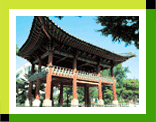
Chungcheongdobyeongmajeoldosayeongmun Tangible
Cultural Properties No. 15 -
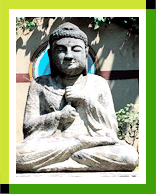
Cheongjuyongamsabirojanabuljwasang (Seated Vairocana Buddha of Yongam Temple)
Tangible Cultural Properties No. 23 -
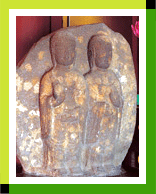
Cheongjubosalsaseokjomijonbyeongnipyeoraeipsang (Standing Twin stone Buddhas of Bosal Temple)
Tangible Cultural Properties No. 24 -
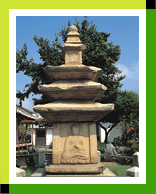
Cheongjutapdongocheungseoktap (Five storied stone pagoda of Tap-dong)
Tangible Cultural Properties No. 25 -
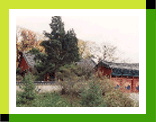
Cheongjuhyanggyo (Cheongju Confucian School)
Tangible Cultural Properties No. 39 -
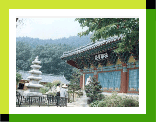
Cheongjubosalsageungnakbojeon (Geungnakbojeon Hall in Bosal Temple)
Tangible Cultural Properties No. 56 -
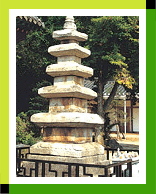
Cheongjubosalsaocheungseoktap (Five-Story Stone Pagoda at Bosal Temple)
Tangible Cultural Properties No. 65 -
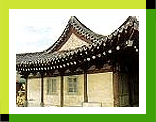
Cheongjudongheon (Cheongju Magistrate's Office)
Tangible Cultural Properties No. 109 -
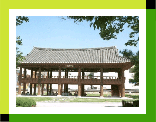
Mangseonnu
Tangible Cultural Properties No. 110 -
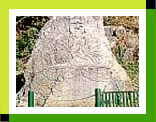
Cheongjujeongharimaaebirojanabuljwasang (Vairocana Buddha Carved from a Rock in Jeongha-ri)
Tangible Cultural Properties No. 113 -
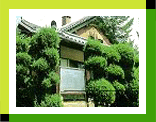
Cheongjutapdongyanggwan (Western style Hall in Tap-dong)
Tangible Cultural Properties No. 133 -
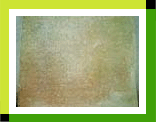
Cheongjuuncheondongsillasajeokbi (Stele of Silla in Uncheon-dong, Cheongju)
Tangible Cultural Properties No. 134 -
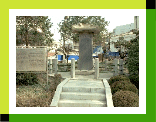
Cheongjujoheonjeonjanggijeokbi (Stele in memory of Jo Heon)
Tangible Cultural Properties No. 136 -
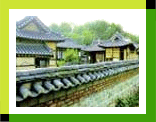
Cheongjusinjeondonggoga (Ancient House in Sinjeon-dong, Cheongju)
Tangible Cultural Properties No. 145 -
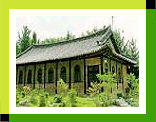
Cheongjuseonggonghoeseongdang (Cheongju Anglican Church)
Tangible Cultural Properties No. 149 -
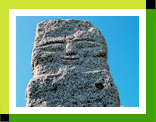
Cheongjusunchimyeongseokburipsang (Standing Stone Buddha statue in Cheongju)
Tangible Cultural Properties No. 150 -
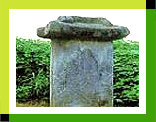
Cheongjuhanssitaejojedanbi (Cheongju Han Clan Taejojedanbi stele)
Tangible Cultural Properties No. 169 -
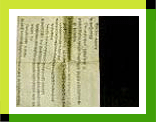
Cheongjuseogisaseokjoyaksayeoraejwasang (Seated Stone Buddha Statue of Seogisa Temple in Cheongju)
Tangible Cultural Properties No. 174 -
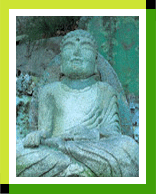
Nuljaegangsuyugopanmok (Wooden printing block of Nuljae's)
Tangible Cultural Properties No. 177 -
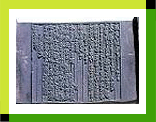
Gwanggukjikyeongmokpanmok (Wooden printing block of Gwangguks)
Tangible Cultural Properties No. 164 -
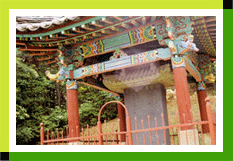
Park Hoon Sindobi (Tombstone)
Tangible Cultural Property No. 181
Park Hoon Sindobi is a large tombstone that stands at the entrance of his graveyard. Park Hoon (1484~1540) was a Confucian scholar who lived during the first half of Chosun period. He was the son of Jeungyoung, a senior secretary of Hongmungwan. In 1504, he passed the government examination and served in various central government posts. And in 1519, he passed a special examination as a master of Classics and served as a royal secretary. However, he was involved in a massacre of scholars that broke out in 1519, and had to spend the next 17 years in political exile. He was released in 1536, but he lived the remainder of his life here in Cheongwon, the hometown of his mother.
The shindobi was written by Park Pilju in 1748, was callilgraphed by Yoon Deukhwa, and inscribed by Yu Cheokgi, and at the back of the tombstone there is an epitaph that was written by Seong Un. In 1957, an wooden monument house with gambrel roof, 1 kan on the front and 1 kan on each side, was erected. The new tombstone had a typical round foundation and a gambrel-type capping stone. The monument, the foundation, and the capping stone were all made of quality granite stone. -
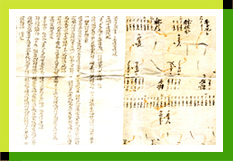
Yeongjo-daewang Taesil Gabong Euigwe (King Yeongjo’s Umbilical Cord Burial Record)
Tangible Cultural Property No. 170
Yeongjo-daewang Taesil Gabongeuigwe (King Yeongjo’s Umbilical Cord Burial Redecoration Record)
Yeongjo-daewang Taesil Gabongeuigwe is a hand-copied book that recorded the background, the process, and the ceremonial procedure involved in redecorating the umbilical burial of King Yeongjo of Chosun Dynasty which is located at Cheongwon-gun Nangseong-myeon Museong-ri
During Chosun period, if a new baby was born in the royal family, his or her umbilical cord was placed in a stone burial for the health and longevity of the baby. Especially, if the baby was enthroned as a king later, a redecoration work was carried out to the burial in order to upgrade it befitting to a king in accordance with a set ceremony and procedure. At the center of a foundation stone was placed a flat oval-shaped stone and a roof-top stone to create a burial around which were placed floor stones and a stone hand-rail to complete the decoration.
According to the ceremonial record or Euigwe, the umbilical cord of King Yeongjo was placed in a burial located at Chungcheong-do Cheongju-mok Sannaeildong-myeon Mussang-ri or the present Museong-ri Taebong-san Myojoa-yuhyang, a first class burial site, around 8 a.m. on September 28, 1695, the location having been designated for the purpose previous year, on September 26, 1694 in accordance with a memorial submitted from Gwansanggan or the Office of Astronomy and Geography.
According to the tradition, the burial had to be redecorated right after the enthronement of King Yeongjo but the construction was postponed until 1729, the 5th year of King Yeongjo's reign, due to the Rebellion of Yi In-Joa that broke out at the time in Cheongju area and successive droughts, when the redecoration began on the recommendation of the Ministry of Education.
This ceremonial record is a valuable historical material for the study of umbilical burial in Republic of Korea as it recorded, in addition to the burial record itself including specifics on the stone structure and the monument, a complete listing of construction work, persons involved, and the number of service personnel, craftsmen, and the monk army mobilized for the purpose together with the materials required to complete the redecoration. -
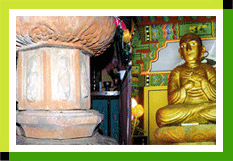
Donghwasa Seokjo Birosanabul Joasang (Donghwasa Seated Vairocana Buddha Statue)
Tangible Cultural Property No. 168
The Buddha statue that is enshrined in Daeungjeon of Donghwasa, commonly known as ‘Namsuweon-jeol’, does not have Gwangbae or the back plate, but otherwise the preservation state is almost perfect. Seated on a high pedestal in lotus position, this statue had a broken neck. Although it was fixed, the repair job was not thorough and the Buddha’s head is slightly turned to the right. Buddha’s hair is in a shape of top-knot but it is not clear, facial expression is abraded, and the body is painted in gold, to the extent that the original shape is hard to verify. Hand shape is also not very clear due to abrasion, but judging from the position of the hands it seems to be jigweon-in, suggesting that the Buddha is a Birosana-bul or Vairocana Buddha. Buddha’s robe flows naturally from both shoulders in a shape of U character in the front and covering both knees. Cloth pattern is highly stylized.
Part of the upper pedestal is broken, but the shape is close to the original. The lower pedestal and below is hidden under the floor, but it was confirmed to sit on a round ground-pedestal and an octagonal base-pedestal. On eight faces of the base pedestal lion figures are displayed in relief.
On octagon-shaped middle pedestal, an incense burner is sculpted on the front, but shown on the rest of seven sides are Buddhas and Bodhisattvas with diverse hand shapes including hapjang-sang, or Buddha status lacking jigweon-in, etc. But in the current middle pedestal, the position of the front and the rear is reversed.
The upper pedestal is in a round shape, the bottom is slightly raised, and the sides are covered with lotus pattern. Judging from overall sculptural techniques, this Buddha seems to have been created during the Silla-Koryo transitional period. Height of the Buddha is 148 cm, height of the head 51 cm, height of shoulders 91 cm, width of shoulders 70 cm, width of the chest 45 cm, height of the knee 28 cm, width of knees 109 cm. As for pedestal, heigt of the middle pedestal is 31.5 cm, height of the upper pedestal 19 cm, and diameter of the upper pedestal is 117cm. -
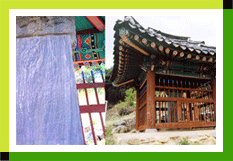
Shin Jungeom Sindobi (Tombstone)
Tangible Cultural Property No. 161
This stele was erected by the government to honor Shin Chung-am(1522-1604), an official during the reign of King Sonjo of Choson (1392-1910).
Shin was a model filial son who took good care of his step-mother and brothers after the death of his parents; a model public servant who conducted his official duties with honesty and austerity; and a gentle magistrate who governed with kindness. When military supplies ran short during the Japanese invasions of 1592-98, Shin contributed grains out of his private stock. He was promoted to a senior grade 3 position in Chungch'ubu(Ministry without Portfolio) for his efforts during the war.
On his 80th birthday, the court further promoted him to the junior grade 2rank, and esteemed scholars and officials such as Yi Hang-pok, Yi Tok-hyong, Yi Su-kwang and Han Sok-pong sent him congratulatory notes and paintings of their own work, which are still kept by his descendants as family treasures. Yi was posthumously promoted to the ministerial rank. The stele, inscribed with an epitaph written by shim Hui-su in 1609, was erected in 1619. -
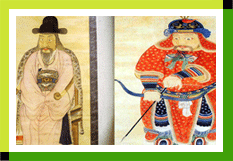
Yoon Gwan Yeongjeong (Portrait)
Tangible Cultural property No. 160
The two portraits enshrined in this Honamsa shrine are of Yun Kwan(?-1111), an outstanding general during the Koryo Kingdom (918-1392) who contributed greatly to vanquishing the Jurchens.
According to the information of the P'ap'yong Yun clan, they are copies of the original portraits enshrined in Malloesa Shrine in Hamgyongbuk-do Province, but they have not been verified because there is no mention of a shrine of that name in Tonggukyojisungnam(Augmented Survey of the Geography of Korea).There is a mention of a shrine being built to him in Hamgyong-do in 1583 in another publication, however.
Neither of the portraits seems to be an attempt to present a true likeness of the model. They are rather deified, symbolic presentations of Yun Kwan. The one in armor is in a fashion common to Buddhist paintings of Sach'onwang(Lokapala). They are thus of more value as folkloric materials than as protraits. -
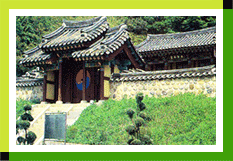
Jung Soochung Yeongjeong (Portrait) and Yeongjeong Jungmogi
Tangible Cultural Property No. 159
Chong Su-ch'ung (1401-69) was a Choson period (1392-1910) government official who passed the state civil service examination in 1450. He was made Meritorious Official Grade 3 for helping enthrone King Sejo(r. 1455-68). His highest post was Fourth State Councillor.
This portrait is a copy of one believed to have been painted in 1455 in commemoration of Chong's citation, as it is in the same style as the official portraits of Shin Suk-chu and Yi Sung-won who were cited at the same time as Chong.
Chong, clad a black hat and crimson court robe, is depicted with his face turned slightly to the right, a pose typical of official portraits. The angular outline of the robe and the linear depiction of the folds represent an ancient style.
This copy was made by a local artist named Yi Sok-myong. The circumstances under which the copy was made is recorded together with a dedicatory address. It is thus valuable to the study of portrait painting of Choson. -
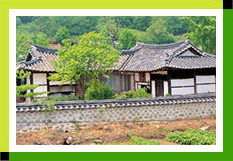
Shin Hyungho Goga (Old House of Shin Hyungho)
Tangible Cultural Property No. 148
This is a Korean-style house that was constructed in 1881. Originally, there were the inner house, the outer house, a storage room, an outer court-house, and a servant quarter. But during the Japanese invasion of the late 19th century, the old house was burnt by the Japanese as Shin Jungsik, the master of the old house, was helping the righteous Korean popular army, leaving only the inner house.
Inner house is so structured that, with the main floor in the center, a kitchen and an across-the-room with veranda are located on the left and a kitchen, an inner room with veranda, and an upper room are located on the right. The inner house, shaped like a ‘ㄱ’ character, is 5 kan on the front and 4 kan on the sides in size. It has a gabled tile-roof on a single layer of eaves. -
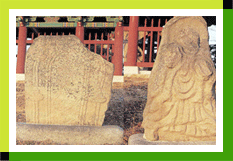
Bijung-ri Seokjo Ilgwang Samjon-bulsang (Three Stone Buddha Statues of Bijung-ri with One Back Plate)
Tangible Cultural Property No. 114
Three Stone Buddha Statues with One Back Plate is located at Bijung-ri, commonly known as Seondol-geori, along the roadside that leads from Naesu to Chojeong Yaksu or Mineral Spring. This Buddha Statue is restored from four broken pieces - the main body, the head, and the assisting Bodhisattva on the right. The fourth piece or the assisting Bodhisattva on the right is not recovered yet.
The Main Buddha, sitting in a lotus position, is damaged around the head, shoulder, and part of the chest, but it shows confident and soft sculpting techniques at the same time. Judging from the shape of knee and the robe covering it, this statue is rather similar to the Seokjo Yeorae Joasang (Seated Stone Buddha Status) that was discovered at Buyeo Gunsu-ri.
As for hand shape (su-in), the raised right hand has a bent index finger as in simuoe-in and the left hand rests softly on Buddhas’ knee, but identification is difficult due to severe abrasion. The robe looks like exposing right shoulder but verification is difficult due to severe abrasion of shoulders and chest. Below the robe covering knees is sculpted a three-Buddha statue, and on both sides a lion figure is sculpted in relief but, again, verification is not easy.
Head and body hollows are represented in several folds of round pattern as seen in water waves, and around them are represented 10 Buddha incarnations. The assisting Bodhisattva on the right has a smile around the lip although identification is difficult. Other features include long hair, cylinder-type body, and X-shaped robe pattern, providing valuable clues for estimating the time of creation for this Buddha statue, most likely around the 6th century. -
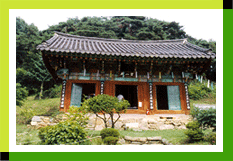
Ansimsa Birojeon (Ansimsa Vairocana Sanctum)
Tangible Cultural Property No. 112
This hall was dedicated originally to Vairocana, the Buddha of Immeasurable Light, but it now enshrines images of arhans, and the disciples of Sakyamuni, the Historic Buddha. It is sometimes called Yongsanjon, a name generally used for halls dedicated to arhans.
The hall was constructed in 1613 and extensively repaired in 1842. It is three kan wide and two kan deep (kan is a traditional unit of measure referring to the space between two columns) with a gabled roof. The eaves are bracketed in a multi-cluster style with two sets of bracket arms protruding both inside and outside the building. Natural stones are used as plinths to support the round pillars. The entire facade is latticed doors.
Faithful to a late Choson (1392-1910) architectural style, the building provides a good comparative study with the Taeungjon Hall which was constructed in the mid-Choson period. -
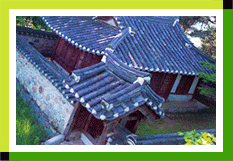
Jiseonjeong (Pavilion)
Tangible Cultural Property No. 111
Jiseonjeong is a pavilion that was built by O Myungrip (Jiseon) in 1610, with the name Jiseon coming from his literary style. The present Jiseonjeong was a rebuilt one in 1879, which was repaired in 1879. The pavilion is 3 kan on the front and 2 kan on the sides, a wooden structure with a gabled tile-roof on a single layer of eaves.
In the interior, a 2-kan floor was installed, and a plate written by Song Siyeol (Uam) is hanging. On the outside, another plate that was written by Kwon Sangha (Suam) entitled Jiseonjeong is hanging. -
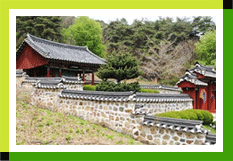
Mukjeong Yeongdang (Portrait Shrine)
Tangible Cultural Property No. 108
This shrine was built in 1888, the 25th year of King Kojong(r. 1863-1907) to enshrine the portrait of Shin Suk-chu. On a 231㎡ lot, the wooden shrine has a gabled roof of tiles. The floor of the portrait chamber is wood and the chamber has a niche for holding the portrait.
The full-length painting of the seated Shin is believed to be a copy of the portrait in the Kubong Portrait Shrine which was painted during the reign of King Yongjo(r. 1724-76). A eulogy on that portrait composed by Minister of War Chong Pom-che(1723-1801) is also found on this one. Although a copy, this portrait is characteristic of early Choson period(14-16th centuries) portraiture of high ranking officials. It is rendered exquisitely. -
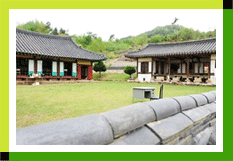
Munui Hyanggyo (Confucian School)
Tangible Cultural Property No. 94
Muneui Hyanggyo was a government school that was established in Muneui. Originally, it was located on the edge of Yangseongsan, 1 ri to the west from the present location. In 1609, the school was moved to Gisan-ri, 3 ri to the south from the county seat. It was moved again in 1683 by country magistrate Li Eonyu to the present location, who thought the existing school compound was not flat enough. -
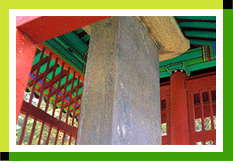
Choi Myunggil Sindobi (Tombstone)
Tangible Cultural Property No. 59
Choi Myunggil (1586∼1647; Jicheon) was a court official during the reign of King Injo. His posthumous epithet was Munchung. His ancestors’ native place was Jeonju, and he was a son of Kinam who served as Youngheung Prefect.
Choi Myunggil passed the government examination in 1605 and served, among other positions, as a librarian of Yemungwan. When the court was in disarray due to misgovernment of Gwanghae-gun, Choi successfully invited a new king, Injo, together with Kim Yu and Li Gwi. For the contribution, Choi was appointed as one of chameui, a first-class meritorious official, and was given the title Wanseong-gun.
During the invasion of Manch army in 1628, Choi advocated peace policy, thereby playing a role in the court’s surrender to the Ching. But with the ‘peace court’ established in Seoul, he became one of the state ministers serving as U-euijeong, Joa-euijeong, and finally Yeong-euijeong, the prime minister, in sequence.
Choi Myunggil was famous for his scholarship in Neo-Confucianism and literary skill. His calligraphy was well known as Donggichang (Tung Ch’ich’ang) style. His writings include Jicheon-jip 19 volumes, Gyeongseo Gieui, and Byungja Bongsa. The Sindobi (Tombstone) was established in 1702, to which was added a shrine in 1979. -
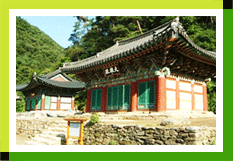
Weolrisa Daeungjeon
Tangible Cultural Property No. 58
According to a tablet belonging to Weolrisa, Weolrisa Daeungjeon was originally Sinheungsa, a nearby temple, which was moved by Master Priest Weonhak to the present location in 1657. Judging from an inscription discovered from a roof-top tile, the Daeungjeon underwent a major repair in 1730.
From the architectural style as well, this building seems to have been constructed in the mid-Chosun period. The building is 3 kan on the front and 3 kan on the sides. It had a gabled tiled-roof and had dapo-style columns. On the base foundation piled up high using natural stones, natural stone jochoseok were employed, and corner pillars were thicker and higher than plain pillars.
‘井’ character doors were installed in-between the pillars on the front, dugong were tightly arranged, and salmi tips were sharply raised.
Eaves are dual-layered, and at four corners hwalju were erected to support the rafter tips, enhancing the beauty of Korean-style architecture that is commonly found in buildings with a gabled tile-roof. -
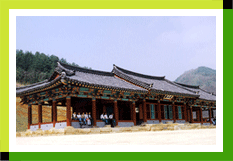
Munsangwan
Tangible Cultural Property No. 49
Built in 1666, this structure is believed to be a government office or a guest house of the Munui magistrate. It was moved to here in 1979 because of the construction of the Taech'ong Dam.
On both sides of the tile-roofed main building is an attached building with a hipped-and-gabled roof.
There are corridors between the main building and the annexed ones. The materials and construction techniques indicate that the buildings were built during different periods.
The structure looks more like a guest house than a government office. In fact, this kind of construction can be seen in the guest house in Chonju, Chollabuk-do Province. An inscription on one of the concave tiles shows that the building was reparied in 1728. The structure is quite important to the study of architectural styles of the middle Choson period. -
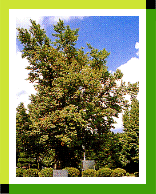
Aapgaksu
(Ginkgo tree in Jungang Park)
Monuments No. 5
It is a nine-hundred-year-old ginkgo tree in the Jungang Park. According to the book on the geography of Korea titled "Dongkuk-yeojiseungnam", this tree has a famous anecdote. The story says that, during the reign of King Gongyang of the Goryeo Dynasty, some loyal cabinet members, wrongly imprisoned, managed to survive the great flood by climbing up this tree. On hearing of it, the king released them saying their survival was the proof given by the heaven that they were innocent. -
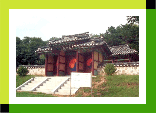
Dongnaebusasongsanghyeonchungnyeolsa (Chungnyeolsa Shrine of Song Sanghyeon)
Monuments No. 16 -
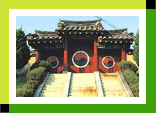
Pyochungsa (Pyochungsa Shrine)
Monuments No. 17 -
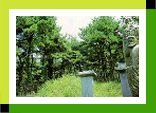
Yeondamgongmyoso (Tomb of Yeondamgong)
Monuments No. 20 -
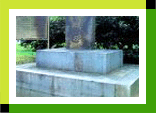
Cheokhwabi(Non-compromise stele)
Monuments No. 23 -
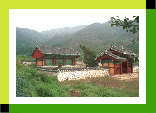
Sinhangseowon
Monuments No. 42 -
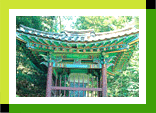
Songsanghyeonmyososindobi (Tomb and Monument of Song Sanghyeon)
Monuments No. 66 -
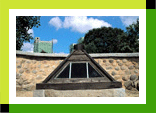
Bangjeong (Bangjeong Wall)
Monuments No. 84 -
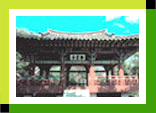
Munongjeongji (Munongjeong Pavilion site)
Monuments No. 85 -
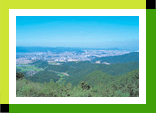
Gagyeong-dong Monument
Monuments No. 120 -
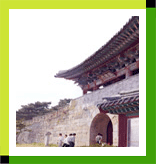
Bumosanseong (Bumo Mountain Fortress)
Monuments No. 121 -
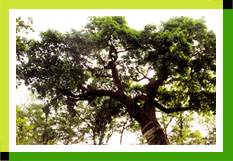
Gongbuk-ri Eum tree
Natual Monument No. 305
This tree is 8.5m high, 4.5m in circumference at chest heigh, and believed to be about 700 years old. This is native to Republic of Korea and grows in the mountains throughout the country. It is a deciduous and tall tree with many thorns on the young stems and branches but no thorns at the aged trunk. Because of thorny branches it was believed that is had the power to expel evils. -
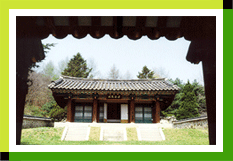
Danjae Yeongdang and Myoso (Portrait Shrine and Graveyard)
Monument No. 90
Danjae Yeongdang is a portrait shrine that was established in 1978 to commemorate Shin Chaeho (Danjae; 1880∼1936) who was an independence fighter, a historian, and a journalist during the period of Japanese occupation and enshrine his portrait right in front of his grave.
The portrait is an ink-and-color painting on silk of Danjae sitting on a chair based on the original painting drawn by Han Gwangil. The shrine is a wooden structure, 3 kan on the front and 1 kan on the side, which has a gabled tile-roof with a dual layer of eaves. In the interior, a floor and a 4-piece door were installed together with a small frontal floor. On the outside, a plate entitled Danjae Yeonggak meaning Danjae Portrait Shrine was hung. And in front of the shrine, a 3-piece door entitled Jeongki-mun was constructed. The whole compound was surrounded by a fence.
Danjae’s grave was placed in a site where the house he lived in when he was young stood as he died in a Lu Shun prison on February 21, 1936 where he was serving his term for his activity in relation to the Far East Anarchists Alliance. In the graveyard, there stood a grave mark prepared by such figures as Han Yongun, O Sechang, and Shin Baek’u. Besides, there also stands a tombstone that was erected in 1972. -
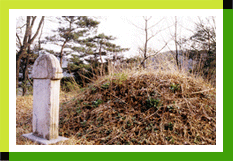
Cheongwon Sandeokri Taesil (Umbilical Cord Burial)
Monument No. 86
Taesil, also known as taebong, is a burial site, especially a stone burial of an umbilical cord belonging to the royal family. During the Chosun period, a taesil dogmam was established temporarily when a baby was born in the royal house, so that an official in charge called Antaesa could look for an auspicious site to lay a stone burial.
As there was a taesil in Cheongwon, there was a mountain name called taebong. The burial box that was buried there was in a shape of cylinder with a capping stone. A stone burial and a capping stone were separately prepared to contain the umbilical cord jar before a complete grave could be completed. -
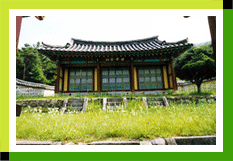
Chehwadang-sa (Shrine)
Monument No. 73
This is a shrine built to honor four brothers of the Kyoha No clan; No Kyewon, No Chun-won, No Chong-won and No I1-won. Local scholars during the reign of King Sonjo (r. 1567-1608) of Choson (1392-1910), they were famous for their filial piety and brotherly love. It is said that Sonjo awarded a plaque with the name Ch'ehwadang in his own calligraphy to the four brothers on the recommendation of Prime Minister Yu Song-ryong.
A shrine was built by their descendants in 1701 in Kasan-ri, Namil-myon but it was destroyed during the reign of King Kojong(r. 1863-1907) when all private Confucian shrine-schools were abolished by royal order. This one was built in 1967 by the No clan. The monument with a record of the history of the shrine, which was erected in 1719, was moved from the original location at that time. -
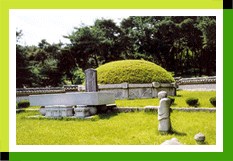
Han Ran Myoso and Sindobi (Han Ran Graveyard and Tombstone)
Monument No. 72
This is the graveyard and Sindobi (Tombstone) that commemorate the contributions Taewi Han Ran (853~916) made to the founding of Koryo Dynasty.
Han’s original grave was damaged in 1659 by No Bong, so Han’s descendents restored the grave in 1690. Although transformed due to this incidence, the tombstone and the gravestone are still extant. Stone figures representing officials and animals guarding the grave are still well preserved. -
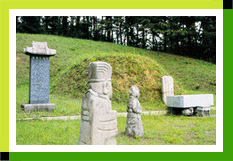
Park Kwang-u Myoso (Park Kwang-u Graveyard)
Monument No. 71
This is the tomb of Pak Kwang-u (1495-1545), a scholar official during the reign of King Myongjong(r. 1545-67)of Choson (1392-1910).
Pak Kwang-u passed the state civil service examination with the highest score in 1525, served in many public posts, and participated in the compilation of Yo jisungnam(Survey of the Geography of Korea). He was caught in the factional strife which caused the purge of 1545 and put to death. He was exonerated at the plea of Yi I and his memorial tablet was permitted to be enshrined in Songch'on Sowon Confucian academy.
This tomb is typical of Choson tombs and is valuable for the study of the funerary system of the time. A stone funerary tablet and stone table are placed in front of the mound, and a tomb marker written by Song Shi-yol in 1687 stands to their left. The stone civil official, stone child and the stone pillar are the original ones but the stele and lantern are recent additions. The tomb was moved from P'aju-gun, Kyonggi-do to hee in 1967, at which time a double layered wooden coffin was uncovered along with bronze bells and small porcelain jars. They have been designated Provincial Folklore Materials. -
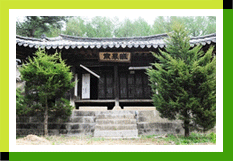
Yeongju-daewang Taesil Yujeok (King Yeongjo's Umbilical Cord Burial Site)
Monument No. 69
According to Chungcheong Doeupji (Chungcheong Provincial Gazetteer), this taesil or umbilical cord burial of King Yeongjo was located in a site that is 20 li apart from Cheongju to the east. The location was Cheongju-mok Sannae Ildong-myeon Mussang-ri, which is today’s Museong-ri.
This taesil or burial, which contained the umbilical cord of King Yeongjo (1694~1776) who was born in 1695 (Sukjong 21), was rebuilt in 1729 in imitation of King Sukjong’s taesil in Gongju to fit the size and the structure for a king’ taesil. The shape also followed the example of King Sukjong’s. An egg-shaped burial stone and an octagonal capping stone were laid on a 2-stage round pedestal at the center and corner stones were erected on octagonal corners. A short square pillar stone was placed at the center of eight sides and a stone fence was placed around a long hexagonal stone.
In front of the burial, the trunk of the tombstone was erected on a turtle-shaped foundation stone on which is placed the burial tablet. On the front of the tablet was written “His Highness’s Umbilical Burial”, on its back was written “Established on October 14, Ongjeong (Yung Cheng) 7”. -
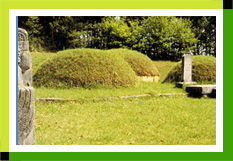
Choi Myunggil Myoso (Graveyard)
Monument No. 68
The center mound is the tomb of Ch'oe Myong-kil (1586-1647), a high government official who advised King Injo (r. 1623-49) to make peace with Ch'ing China in 1636 when the Manchus invaded Republic of Korea. Ch'oe excelled in writing and calligraphy. Prime minister was the highest office held by him.
The stone tomb furniture includes an altar, a grave marker, a pair of posts and a pair of officials. The calligraphy of the inscription on the grave marker was done by Nam Ku-man. A memorial stele to Ch'oe, Ch'ungch'ongbuk-do Tangible Cultural Property No. 59, is located nearby. -
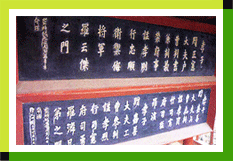
Samse Chunghyo-mun (Three Generation Chunghyo-mun)
Monument No. 40
Samse Chunghyo-mun refers to two shrines, Chungsin-gak (Loyal Servant Shrine) and Samhyo-gak (Three Filial-son Shrine). The former was established to commemorate the loyalty of Kyeongheung Prefect Na Sajong (1440~1491) who died while fighting against Yeojin barbarians in 1719, and the latter was established in 1638 to commemorate filial piety of Sajong’s son Na Ungeol (1456~1493) and Ungeol’s two sons Bin (1473~1495) and Lin (1475~1495).
Na Sajong dies in 1491 while fighting against 5,000 mounted Yeojin barbarians with 50 troops, and his son Ungeol participated in the campaign against Yeojin but committed suicide on the day he completed 3-year mourning period for his deceased father for his failure in revenging his father’s sworn enemy. In like manner, Ungeol’s two filial sons, Bin and Lin, also committed suicide on the day they completed 3-year mourning period for their deceased father for their failure even though they also participated the campaign against Yeojin. In this way, the three generations of Na’s left the precedent of loyalty and filial piety.
Na Sajong was posthumously honored in 1717 as he was awarded the honorary title of Defense Minister for his contribution in the Yeojin campaign together with a posthumous epithet of Chungjeong. The brothers Bin and Lin were equally honored in 1701 as they were awarded the title of a Minister. The Samse Chunghyo-mun that stands facing east at the entrance of the village contains the Chungsin-gak and the Samhyo-gak within a protective fence. -
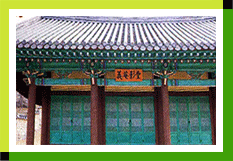
Sohn Byeong-hee Seonsaeng Yuheoji(Old House of Sohn Byeong-hee) Monument No. 30
Sohn Byeong-hee Seonsaeng Yuheoji (Old House of Sohn Byeong-hee) This is the old house where Sohn Byeong-hee (Euiam; 1861~1922) was born and grew up. He joined Donghak early in his life, and led the followers during Donghak Revolution in 1894 in Chungcheong and Gyeongsang Provinces against government forces.
Sohn went into exile to Shanghai by way of Japan and became the third Donghak leader in 1897. In 1904, he organized Jinbohoe and changed its name to Cheondogyo in 1907. After 1910, he took over Boseong College and Boseong Middle School in the name of Cheondogyo to nourish human talent. In the March 1st Movement, Sohn Byeong-hee served as the head of 33 Korean leaders in proclaiming Korean Independence.
Intangible Cultural Properties
-
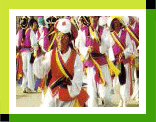
Cheongjunongak (Farmers' Music)
Intangible Cultural Properties No. 1 -
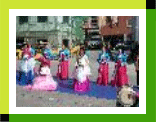
Baecheopjang Hong, Jong-Jin
Intangible Cultural Properties No. 7 -
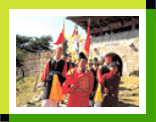
Dancheongjang Gwon Hyeon-Gyu
Intangible Cultural Properties No. 9 -
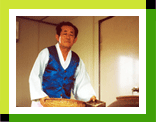
Cheongwon Sinseon-ju (Sinseon Drink
Intangible Cultural Properties No. 4
Sinseon-ju is the only drink that was designated in Cheongwon area as traditional folk drink. This drink, which is produced in Miwon area known for its water taste, is a home-brewed drinks that has been transmitted for more than 400 years encompassing 18 generations of Hamyang Parks. According to the record, the secret to brew this drink has been transmitted from the time of Park Sungsang who settled in this area after he retired from the Governorship of Chungcheong Province. The name Sinseon-ju was derived from an old anecdote according to which Choi Chiwon of the Silla Dynasty period had built a pavilion on Sinseon Mountaintop in front of this village and drank this wine.
Sinseon-ju is manufactured by mixing herb medicines with glutinous rice and yeast for fermentation and obtaining clear wine or distilled liquor. This drink is known to be effective for eloquence, white hair, and longevity. Characteristically, Sinseon-ju has a unique fragrance but no after-effect. One does not get really drunk even after heavy drinking as it keeps one’head clear.
Cultural Properties Materials
-
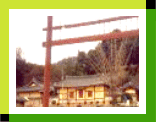
Juseonggangdang
Cultural Properties Materials No. 17 -
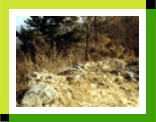
Geotdaesan (geojildaesan) bongsuji (Beacon Tower at Mt. Geotdaesan)
Cultural Properties Materials No. 26